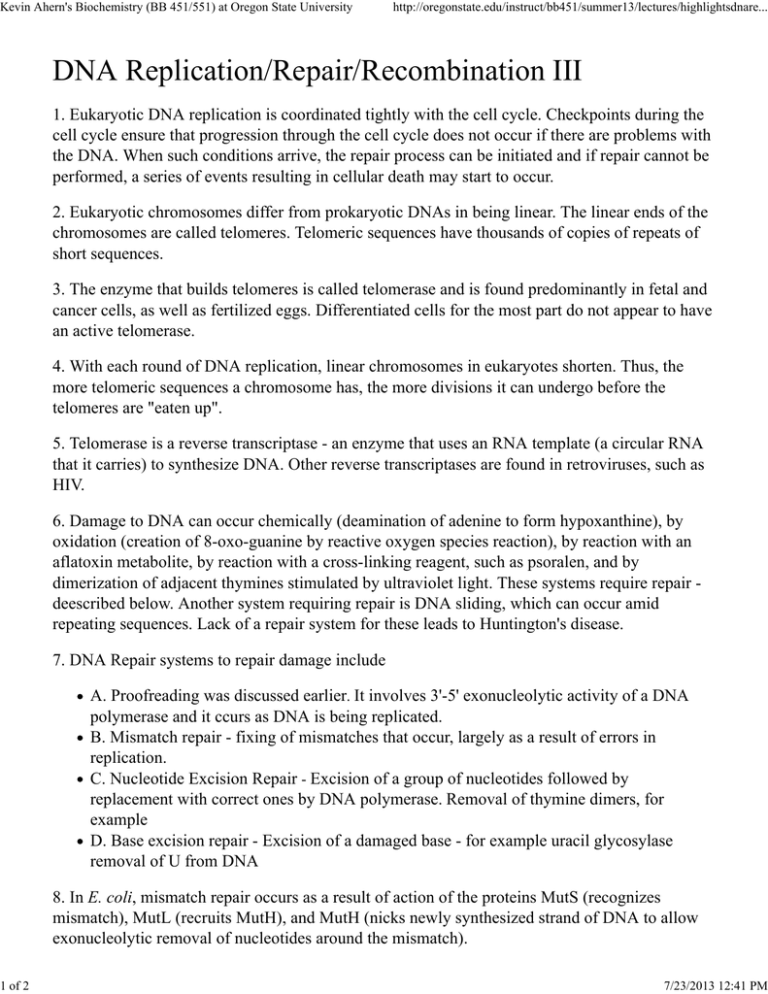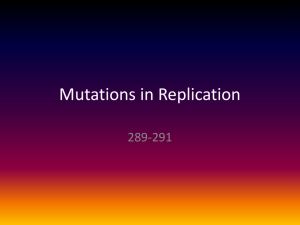Kevin Ahern's Biochemistry (BB 451/551) at Oregon State University
advertisement

Kevin Ahern's Biochemistry (BB 451/551) at Oregon State University 1 of 2 http://oregonstate.edu/instruct/bb451/summer13/lectures/highlightsdnare... DNA Replication/Repair/Recombination III 1. Eukaryotic DNA replication is coordinated tightly with the cell cycle. Checkpoints during the cell cycle ensure that progression through the cell cycle does not occur if there are problems with the DNA. When such conditions arrive, the repair process can be initiated and if repair cannot be performed, a series of events resulting in cellular death may start to occur. 2. Eukaryotic chromosomes differ from prokaryotic DNAs in being linear. The linear ends of the chromosomes are called telomeres. Telomeric sequences have thousands of copies of repeats of short sequences. 3. The enzyme that builds telomeres is called telomerase and is found predominantly in fetal and cancer cells, as well as fertilized eggs. Differentiated cells for the most part do not appear to have an active telomerase. 4. With each round of DNA replication, linear chromosomes in eukaryotes shorten. Thus, the more telomeric sequences a chromosome has, the more divisions it can undergo before the telomeres are "eaten up". 5. Telomerase is a reverse transcriptase - an enzyme that uses an RNA template (a circular RNA that it carries) to synthesize DNA. Other reverse transcriptases are found in retroviruses, such as HIV. 6. Damage to DNA can occur chemically (deamination of adenine to form hypoxanthine), by oxidation (creation of 8-oxo-guanine by reactive oxygen species reaction), by reaction with an aflatoxin metabolite, by reaction with a cross-linking reagent, such as psoralen, and by dimerization of adjacent thymines stimulated by ultraviolet light. These systems require repair deescribed below. Another system requiring repair is DNA sliding, which can occur amid repeating sequences. Lack of a repair system for these leads to Huntington's disease. 7. DNA Repair systems to repair damage include A. Proofreading was discussed earlier. It involves 3'-5' exonucleolytic activity of a DNA polymerase and it ccurs as DNA is being replicated. B. Mismatch repair - fixing of mismatches that occur, largely as a result of errors in replication. C. Nucleotide Excision Repair - Excision of a group of nucleotides followed by replacement with correct ones by DNA polymerase. Removal of thymine dimers, for example D. Base excision repair - Excision of a damaged base - for example uracil glycosylase removal of U from DNA 8. In E. coli, mismatch repair occurs as a result of action of the proteins MutS (recognizes mismatch), MutL (recruits MutH), and MutH (nicks newly synthesized strand of DNA to allow exonucleolytic removal of nucleotides around the mismatch). 7/23/2013 12:41 PM Kevin Ahern's Biochemistry (BB 451/551) at Oregon State University 2 of 2 http://oregonstate.edu/instruct/bb451/summer13/lectures/highlightsdnare... 9. Nucleotide excision repair can be used to repair thymine dimers. Here, a segment of DNA containing the damage is removed by uvrABC excinuclease. The gap is then filled in using DNA Polymerase I and DNA ligase. 10. Base excision repair (uracil repair) involves removal of uracil from DNA by Uracil DNA glycosylase followed by nicking by AP endonuclease, followed by repair by DNA polymerase I and DNA ligase. 7/23/2013 12:41 PM




